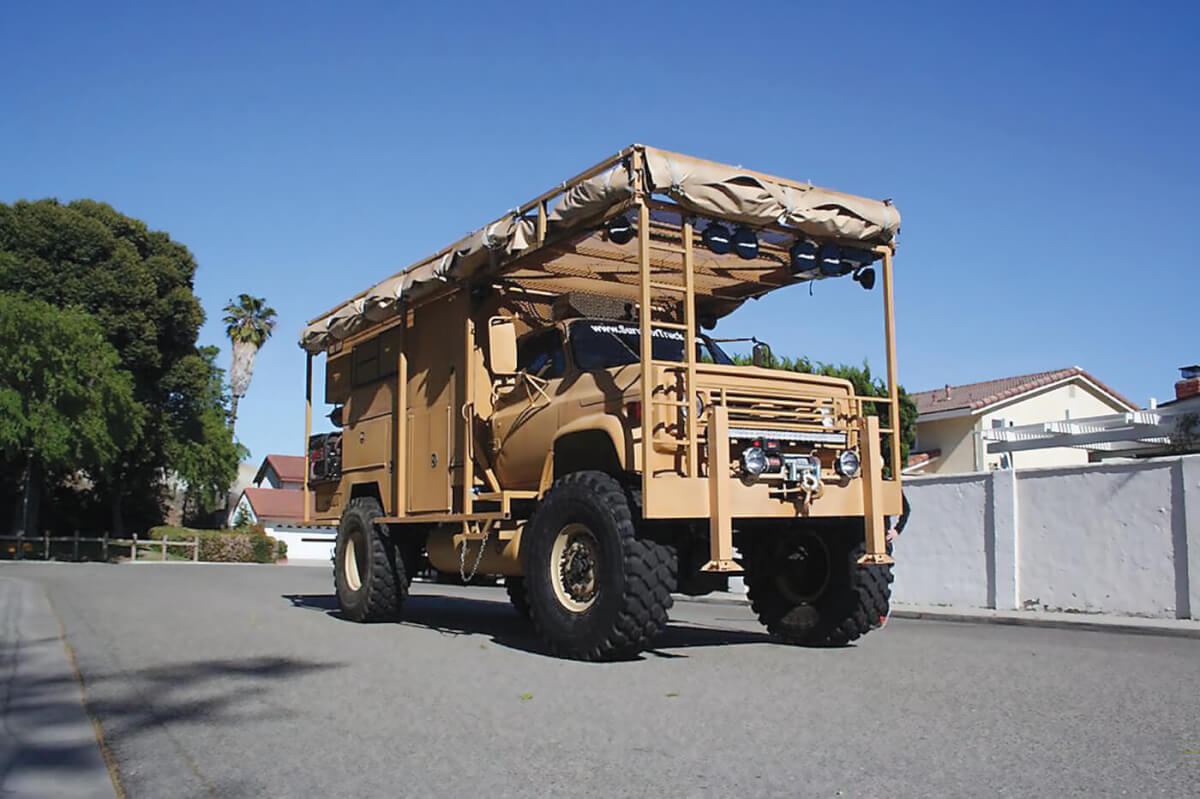“Every time I think, ‘What have I done?’ I get contacted by someone who tells me how impressed they are with it,” Jim DeLozier says.
IN THE DRIVER’S SEAT
Behind the wheel of the ultimate survival truck is, possibly, the ultimate survivalist. Jim DeLozier designs medical devices and gun parts, is a weapons manufacturer, a firearms instructor and an EMT. In his dealings with various levels of emergency, military and law enforcement professionals, he got to thinking about what would happen if he combined the best of the robust vehicles they use in the line of duty.
BACKSTORY
DeLozier then bought a truck—a 1980 Chevy pickup, which was previously a work truck employed as an environmental drill rig. It was in pretty bad shape. DeLozier started to transform it into a vehicle that would offer him and his family the ability to sustain themselves if they had to get out of town. Unfortunately, those ideas quickly got bigger than the truck.
What happened next was the birth of this 13-ton beast. (For perspective, a base-model 2018 Ford F-150 pickup weighs about 4,069 pounds.) Nothing about it resembles its early days; from the tires to the roof and everything in between, the word “survival” was the focus. Modifications, custom-built components, add-ons, bolt-ons and extreme carry-ons turned the Chevy into what DeLozier calls “the biggest, baddest, all-inclusive, all-purpose vehicle ever made.” And yes, it’s street-legal; DeLozier has a standard driver’s license.
MONEY TALK
Price tag? DeLozier estimates that, between the design and engineering alone, it has cost more than $1 million to complete the truck (and it’s still not finished, in his eyes). But he noted that building another one for a customer would cost a lot less, especially when mass production eventually comes into play.
Through his work, DeLozier deals with SWAT teams and military, so he looked at their rigs—Humvees and Grizzlys, for example—as well as motorhomes. Voila, the Survivor Truck!
THE TRUCK
Here’s a closer look at some of the elements that helped to transmogrify a run-of-the-mill truck into a run-of-the-land Survivor Truck.
UP FRONT

- There’s a protective cage around the entire perimeter of the vehicle, from top to bottom.
- The overhang can be used as a sniper/observation platform.
- Under the hood is a Chevy 366 ci tall-block connected to a five-speed manual transmission. Fuel economy? Maybe better than you’d imagine for something of this size and weight; the truck currently gets around 8.5 miles per gallon.
- Underneath is a blast plate.
- There are winches, front and rear. There’s also a crane hook.
- HID lights and light bars are in various locations. Everything on the truck is bulletproof … even the lights.
- Within the frame is a 50-gallon water tank. There are also other water tanks on the exterior and interior of the truck.
- An on-board air compressor, welder and generator are among the bug-out gadgets.
- There are thermal cameras, infrared cameras and laser cameras. Night vision gear is also onboard. The truck has 360-degree video monitoring capability.
- A riser system lifts the camper off the truck so that the command center, which is still a work in progress, has more vertical clearance for standing up and walking around.
- The truck has loads of storage compartments all around and inside it. Firearms, biological gear, saws, water purification, chemical suits and medical kits are among the necessities stored in them.
- The 53-inch, military-style tires utilize a mine-resistant run-flat system. Each tire/wheel setup weighs more than 550 pounds, including the manual-locking hubs. The truck also hauls two full-sized spares.
OUT BACK

- A custom-made canopy is attached all around the top of the protective cage.
- Solar panels are located on the roof, and there’s also a solar generator in addition to a diesel generator.
- The truck is bi-fuel-ready. DeLozier will soon be adding 50-gallon gasoline tanks, equipping the Survivor Truck with 146 gallons of gasoline and 150 gallons of propane.
- Batteries, weighing about 77 pounds each, can be found all over the truck. More than 1,200 pounds in batteries, actually. It is also outfitted with power inverters.
- The truck has more than 1,200 pounds of Rhino Lining, which is a protective coating. The exterior also now has a camo paint job.
- The custom suspension has lift kits as well as extra leaf springs to support/distribute the truck’s massive weight. There are also very large axles and manual-locking hubs for when 4×4 mode is required to traverse rough terrain.
- The truck’s walls have a thermoregulating camouflage system. That means the Survivor Truck won’t appear on thermal imaging: “So we look just like a mound in the middle of the desert,” DeLozier says.
INSIDE

- The inside features an armored command/communications center and a bulletproof safe room. It has a nuclear, biological and chemical filtration system.
- There are two beds, including one disguised as a sitting area. 3. A fridge, burner stove, sink with hot and cold water, shower and toilet, as well as a heater and air conditioning, equal long-term sustainability.
- Inclusion of a fridge, stove, sink with hot and cold water, shower and toilet, as well as a heater and air conditioning, equal long-term sustainability.
- There is ¾-inch fiberglass ballistic paneling inside.
- Among the various electronics is a private encrypted radio network and tablets for monitoring what’s happening outside the vehicle.
Editor’s Note: A version of this article first appeared in the April 2014 print issue of American Survival Guide.


